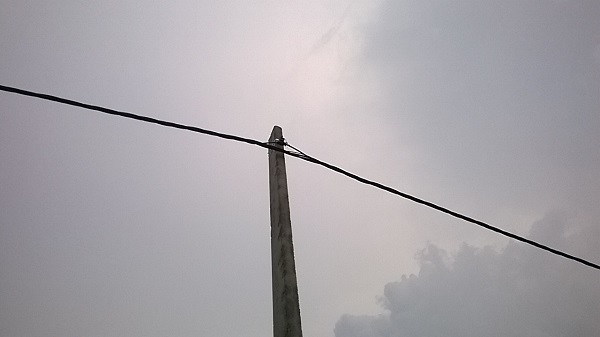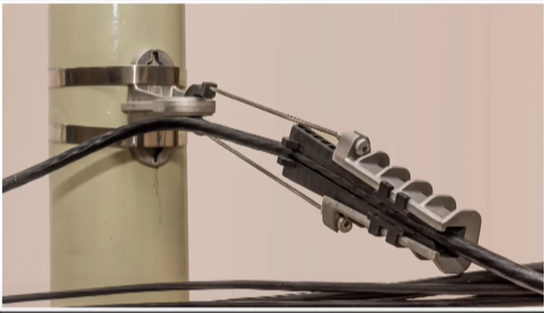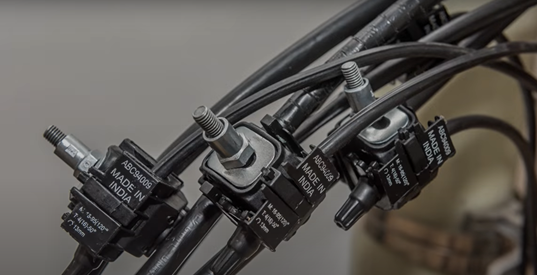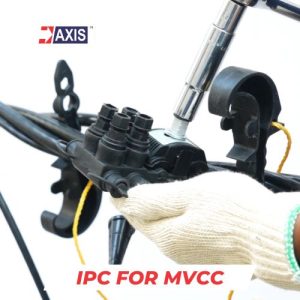What exactly are Covered Conductors?
Covered Conductors are conductors wrapped in insulating material. This wrapping helps prevent accidental contact with other conductors and objects, for example tree branches. They are crucial in Electrical Distribution, because:- They make power distribution and transmission lines more reliable.
- They help cut down power loss in utilities.
- They have a special coating that protects against water and sunlight.
- They keep animals and people safe from electric shocks and reduce power cuts.
Why should DISCOM’s use Covered Conductors?
https://www.youtube.com/watch?v=WVYh2hzDIfI Firstly, DISCOMs, also known as Distribution Utilities, are the companies responsible for distributing electricity to the consumers. In rural distribution networks, power lines often run alongside roads or through hilly areas. These locations are vulnerable due to bad weather conditions. For example, trees often fall onto bare conductor distribution lines in storm-prone locations. This causes the poles to collapse onto the ground and significantly increases the risk of fire and the risk of electrical injury to birds, animals, and humans.Some common risks with using Bare Conductors for Power Distribution:
- Lines are forced to shut down due to fallen trees, high wind, and other natural causes which have an adverse effect on revenue generation for the utility.
- Fire risk to the forest or structures surrounding the bare conductor.
- Risk of electrical injury to birds, animals, and humans.
 Covered Conductors are a key solution to these problems. They have an insulating layer around the conductor, which stops direct contact between the conductor and the ground. This layer protects them from wind, rain, and snow, reducing the chance of earth faults and the risks of fire. It also acts as a barrier against moisture and ultraviolet rays, making the conductor last longer.
Plus, Covered Conductors lead to more reliable power distribution, with fewer power cuts and problems, especially in areas with bad weather. This is the reason DISCOMs use Covered Conductors to make sure power distribution is safe and reliable.
Covered Conductors are a key solution to these problems. They have an insulating layer around the conductor, which stops direct contact between the conductor and the ground. This layer protects them from wind, rain, and snow, reducing the chance of earth faults and the risks of fire. It also acts as a barrier against moisture and ultraviolet rays, making the conductor last longer.
Plus, Covered Conductors lead to more reliable power distribution, with fewer power cuts and problems, especially in areas with bad weather. This is the reason DISCOMs use Covered Conductors to make sure power distribution is safe and reliable.
 To overcome these risks, overhead line conductors provided with an insulating cover have been developed & these are known as Covered Conductors. The main advantage of Covered Conductors over bare overhead & underground lines is their increased safety and lower cost. DISCOM’s are increasingly moving to Covered Conductors to ensure reliable power distribution.
To overcome these risks, overhead line conductors provided with an insulating cover have been developed & these are known as Covered Conductors. The main advantage of Covered Conductors over bare overhead & underground lines is their increased safety and lower cost. DISCOM’s are increasingly moving to Covered Conductors to ensure reliable power distribution.
Types of Covered Conductor Accessories
Let’s take a closer look at some of the commonly used covered conductor accessories like dead end/anchoring clamps, plastic insulator ties, insulation piercing connectors, and pre-insulated junction sleeves for medium voltage (MV) covered conductors.Dead End/Anchoring Clamps
 Dead end/anchoring clamps are used to anchor the covered conductor and provide tension to the line. Specially engineered plastic wedges grip the conductor firmly without harming the insulation, ensuring a long life for the conductor. In addition, an anti-tracking insulation piercing connector is used to prevent partial discharges and radio disturbances. These clamps are delivered ready-to-use, which saves time and effort during installation. The voltage range for these clamps is 11kV to 33kV, and they can withstand temperatures ranging from -30°C to 75°C. The body of the clamp is made of corrosion-resistant aluminum alloy, while the wedges are made of UV-stabilized engineering plastic.
Dead end/anchoring clamps are used to anchor the covered conductor and provide tension to the line. Specially engineered plastic wedges grip the conductor firmly without harming the insulation, ensuring a long life for the conductor. In addition, an anti-tracking insulation piercing connector is used to prevent partial discharges and radio disturbances. These clamps are delivered ready-to-use, which saves time and effort during installation. The voltage range for these clamps is 11kV to 33kV, and they can withstand temperatures ranging from -30°C to 75°C. The body of the clamp is made of corrosion-resistant aluminum alloy, while the wedges are made of UV-stabilized engineering plastic.
Plastic Insulator Ties
In the case of these types of Covered Conductor Accessories, plastic insulator ties are used to secure the covered conductor into insulators. Made of UV and weather-resistant engineering plastic, they are easy to install and provide a firm grip to insulators. These ties are recommended for angles up to 15° and can handle voltages ranging from 11kV to 33kV. They can also withstand temperatures ranging from -30°C to 75°C.Insulation Piercing Connectors
 Insulation piercing connectors are used to take tap connections to continue or distribute the line. The body of the connector is constructed from UV-stabilized engineering plastic to help sustain harsh environmental conditions. These connectors are completely waterproof, ensuring that no water ingress occurs. The voltage range for these connectors is 11kV to 33kV, and they can withstand temperatures ranging from -30°C to 75°C.
Insulation piercing connectors are used to take tap connections to continue or distribute the line. The body of the connector is constructed from UV-stabilized engineering plastic to help sustain harsh environmental conditions. These connectors are completely waterproof, ensuring that no water ingress occurs. The voltage range for these connectors is 11kV to 33kV, and they can withstand temperatures ranging from -30°C to 75°C.
Pre-Insulated Junction Sleeves
Pre-insulated junction sleeves are used to connect two ends of the cable. The outer insulation is constructed from UV and weather-resistant engineering plastic, and the connection is completely waterproof to prevent any water ingress. These sleeves are easy to crimp with standard hexagonal dies, eliminating the need for new special tools. The voltage range for these sleeves is 11kV to 33kV, and they can withstand temperatures ranging from -30°C to 75°C. In conclusion, the proper functioning of covered conductors is essential for safe and reliable power transmission. The use of dead end/anchoring clamps, plastic insulator ties, insulation piercing connectors, and pre-insulated junction sleeves can greatly improve the efficiency and safety of covered conductors. When selecting these components, it is important to consider the voltage and temperature range required for the specific application, as well as the material and environmental conditions. At Axis, we are proud contributors towards rural electrification projects across the country. Electrification in India, however, is plagued with large Aggregate Technical & Commercial (AT&C) losses that harm the DISCOM’s long-run health and ability to reinvest in rural electrification projects. These DISCOMs have been under severe financial stress for many years with total external debt estimated to reach Rs. 2.6 lakh crore by March 2020 according to the credit rating agency CRISIL but they have also gotten some relief through a 90,000 crore lifeline to fight the Covid-19 crisis.
Innovative technologies such as Smart Meters and AB Cables aim to reduce AT&C losses for Indian utilities. Another innovative technology is Covered Conductors that are used for applications up to 132kV.
I hope you know have a clear idea about the types of Covered Conductors Accessories and why they are essential for DISCOMs. At Axis, we are proud of our contribution to rural electrification projects in more than 50 DISCOMs across India, Africa and the globe. Axis products were critical to the success of government schemes like SAUBHAGYA and currently during RDSS as well, playing a key role in enhancing electrical infrastructure.
At Axis, we are proud contributors towards rural electrification projects across the country. Electrification in India, however, is plagued with large Aggregate Technical & Commercial (AT&C) losses that harm the DISCOM’s long-run health and ability to reinvest in rural electrification projects. These DISCOMs have been under severe financial stress for many years with total external debt estimated to reach Rs. 2.6 lakh crore by March 2020 according to the credit rating agency CRISIL but they have also gotten some relief through a 90,000 crore lifeline to fight the Covid-19 crisis.
Innovative technologies such as Smart Meters and AB Cables aim to reduce AT&C losses for Indian utilities. Another innovative technology is Covered Conductors that are used for applications up to 132kV.
I hope you know have a clear idea about the types of Covered Conductors Accessories and why they are essential for DISCOMs. At Axis, we are proud of our contribution to rural electrification projects in more than 50 DISCOMs across India, Africa and the globe. Axis products were critical to the success of government schemes like SAUBHAGYA and currently during RDSS as well, playing a key role in enhancing electrical infrastructure.
FAQ
MVCC (Medium Voltage Covered Conductor) accessories are used to install, secure, connect, and protect covered conductors in medium voltage power distribution networks, typically ranging from 11kV to 33kV. They ensure mechanical strength, electrical performance, and safety under harsh environmental conditions.
IPCs allows quick and reliable connections without stripping the conductor’s insulation. They provide a low-resistance electrical connection, save installation time, and reduce the risk of conductor damage, making them ideal for new installations, upgrades, and earthing applications.
MVCC systems use tension clamps, suspension clamps, and alignment ties. These clamps ensure secure conductor holding, directional changes, and stable suspension of conductors while maintaining insulation integrity and preventing mechanical stress & damage.
Arc protection devices are critical in preventing fire hazards and damage due to electrical arcs caused by electrical faults. These devices ensure safe operation, especially in forested, urban, or wildlife-sensitive areas.
Yes, all MVCC accessories including clamps, IPCs, joints, and arc protectors comply with international standards such as BS EN 50397-2, ensuring consistent quality, performance, and safety.







